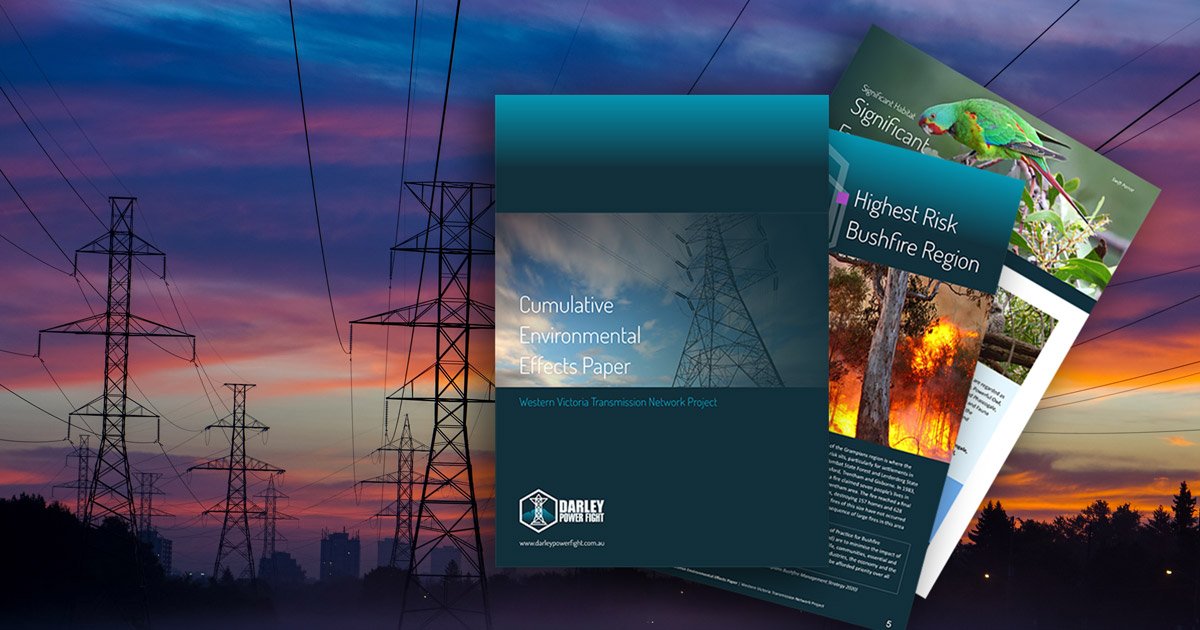Final Corridor Announced – Our Fight is Not Over
Please become an official member of Darley Power Fight today
As you are no doubt aware, AusNet have today announced their final preferred transmission corridor. It is apparent that the shortest route far outweighs any effects on community and environment. While this news is heartbreaking for many, the fact remains that the corridor was always going to be somewhere.
This does not mean that our fight is over.
This corridor will be further investigated as part of the EES process and final proposed route selected by the end of 2021. What this means is we need to stand together and work hard NOW to remain strong in our call to #burythecables. The WVTNP must go underground to avoid and minimise the many cumulative environmental effects.
Over several months, I have been working on the production of a Cumulative Environmental Effects Paper, detailing the impacts on Darley, Coimadai and Merrimu. This document (which you can download below) has been shared far and wide with state and federal ministers, key decision makers, the Technical Reference Group for the EES and other related parties.
It is now time to step up our fight and to call out AEMO and AusNet Services for their poor planning decisions.
According to AEMO (2020 ISP Appendix 8. Resilience and Climate Change1), “good engineering design will ensure that any new infrastructure does not lead to unsustainable deterioration in grid resilience”. Building additional transmission lines along a bushfire prone transmission corridor would be an example of resilience deterioration“.
Overhead transmission infrastructure, proposed through bushfire prone areas and nearby township settlements, is highly inappropriate and represents one of the worst locations in the state for this project to be routed. According to Forest Fire Management Victoria, the eastern half of the Grampians region is where the greatest bushfire risk sits, particularly for settlements in and around the Wombat State Forest and Lerderderg State Park, such as Daylesford, Trentham and Darley.
The risk to human life and deterioration in grid resilience directly contravenes strategic planning objectives which is to minimise the impact of major bushfires on human life, communities, essential infrastructure, economy, and the environment. Human life should and will be afforded priority over all other considerations.
Become a member and let’s stand together
We come from all walks of life, but one thing is common, we do not want overhead transmission lines in our back yard, this project must go underground. Now more than ever, we need to demonstrate we have community support so please become an official member of Darley Power Fight today.
If you are passionate about preserving our stunning region and protecting your home from the many impacts of the WVTNP, join now so we can stop this together.
For more information on the proposed final corridor, visit the WVTNP website. To download the latest documents and the Darley Power Fight Cumulative Environmental Effects Paper, please see links below.
Reference

Join Now
Get Involved
The only way to make a difference is to get involved. It’s easy to sit back and wait for others to do something but when you are staring at 75-85m towers in a few years time, you will kicking yourself for not doing something when you had the chance. This is OUR only chance to stop these towers, so get involved now.
Welcome to the home of Darley Power Fight. A group of residents in Darley, Coimadai and Merrimu, united against high voltage transmission towers passing through our backyard. We came together through the realisation the transmission line will divide a narrow corridor between Darley and the Lerderderg State Park; altering landscape character, causing widespread damage to critical habitat for threatened species, increasing fire risk to the Park and thousands of residents, destroy our visual amenity, harm local agriculture and will impact businesses and property values. It will completely desecrate, in a few years, what nature has taken millions of years to create.


